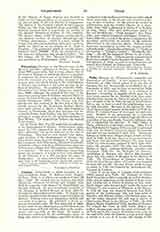

Tulle, Diocese of (TUTELENSIS), comprises the Department of Correze. It was suppressed by the Concordat of 1802, which joined it to the See of Limoges, but was theoretically reestablished by the Concordat of 1817, and de facto reerected by Bulls dated 6 and October 31, 1822. It is suffragan of Bourges. According to legends which grew up in later years around the St. Martial cycle, that saint, who had been sent by St. Peter to preach, is said to have restored to life at Tulle the son of the governor, Nerva, and to have covered the neighboring country with churches. By some of the legends St. Martin of Tours is made founder of the Abbey of Tulle; by others, St. Calmin, Count of Auvergne (seventh century). Robbed of its possessions by a powerful family, it recovered them in 930 through the efforts of a member of the same family, Viscount Adhemar, who left a reputation for sanctity. St. Odo, Abbot of Cluny, reformed it in the tenth century. John XXII by a Bull dated August 13, 1317, raised it to episcopal rank; but the chapter remained subject to monastic rule and was not secularized until 1514. Among the bishops of Tulle were: Hugues Roger, known as Cardinal de Tulle (1342-43), who was never consecrated, and lived with his brother Clement VI; Jean Fabri (1370-71), who became cardinal in 1371; Jules Mascaron, the preacher (1671-79), who was afterwards Bishop of Agen; Leonard Berteaud, preacher and theologian (1842-78). St. Rodolphe of Turenne, Archbishop of Bourges, who died in 866, founded, about 855, the Abbey of Beaulieu in the Diocese of Tulle. The Charterhouse of Glandier dates from 1219; the Benedictine Abbey of Uzerche was founded between 958 and 991; Meymac Priory, which became an abbey in 1146, was founded by Archambaud III, Viscount de Conborn.
Urban II on his way to Limoges from Clermont (1095) passed near Tulle. St. Anthony of Padua dwelt for a time at Brive, towards the end of October, 1226; and the pilgrimage to the Grotto of Brive is the only existing one in France in honor of that saint. Pierre Roger, who became pope under the name of Clement VI, was a native of Maumont in the diocese. In 1352 the tiara was disputed between Jean Birel, general of the Carthusians, who had been prior of Glandier, and Etienne Aubert, who became pope under the name Innocent VI, and was a native of Château-des-Monts in the Diocese of Tulle. In 1362 Hugues Roger, Cardinal of Tulle, brother of Clement VI, refused the tiara; in 1370 Pierre Roger, his nephew, became pope under the name of Gregory XI. At Tulle and in Bas (Lower) Limousin, every year, on the vigil of St. John the Baptist, a feast is kept which is known as le tour de la lunade (the change of the moon); it is a curious example of the manner in which the Church was able to sanctify and Christianize many pagan customs. Legend places the institution of this feast in 1346 or 1348, about the time of the Black Death. It would seem to have been the result of a vow made in honor of St. John the Baptist. M. Maximin Deloche has shown that this legend is baseless; that the worship of the sun existed in Gaul down to the seventh century, according to the testimony of St. Eligius, and that the feast of St. John’s Nativity, June 24, was substituted for the pagan festival of the summer solstice, so that the tour de la lunade was an old pagan custom, sanctified by the Church, which changed it to an act of homage to St. John the Baptist.
Among the saints specially honored in, or connected with the diocese, besides those already mentioned, are: St. Fereola, martyr (date uncertain); St. Martin of Brive, disciple of St. Martin of Tours, and martyr (fifth century); St. Duminus, hermit (early sixth century); at Argentat, St. Sacerdos, who was Bishop of Limoges when he retired into solitude (sixth century); St. Vincentianus (Viance), hermit (seventh century); St. Liberalis, Bishop of Embrun, died in 940 at Brive, his native place; St. Reynier, provost of Beau-lieu, died at the beginning of the tenth century; St. Stephen of Obazine, b. about 1085, founder of the monastery for men at Obazine, and that for women at Coyroux; St. Berthold of Malefayde, first general of the Carmelites, and whose brother Aymeric was Patriarch of Antioch (twelfth century). Etienne Baluze, the learned historian (1638-1718), was a native of Tulle, and the missionary Dumoulin Bove (1808-38), who was martyred in Tonquin, was born in the diocese. The chief pilgrimages of the diocese are: Notre-Dame-de-Belpeuch, at Camps, dating from the ninth or tenth century; Notre-Dame-de-Chastre at Bar, dating from the seventeenth century; Notre-Dame-du-Pont-du-Salut, which goes back to the seventeenth century; Notre-Dame-du-Roc at Servieres, dating from 1691; Notre-Dame-d’Eygurande, dating from 1720; Notre-Dame-de-La-Buissiere-Lestard. which was a place of pilgrimage before the seventeenth century; Notre-Dame-de-La-Chabanne at Ussel, dates from 1140; Notre-Dame-de-Pennacorn at Neuvic, dating from the end of the fifteenth century.
Before the application of the Law of 1901, the Diocese of Tulle contained Carthusians, Franciscans, Sulpicians, Assumptionists, Fathers of the Third Order of St. Francis of Assisi, and many teaching congregations of Brothers. The teaching Sisters of the Sacred Heart of Mary had their mother-house at Triegnac. The religious congregations were in charge of 6 nurseries, 2 orphanages for boys, 5 orphanages for girls, 1 Good Shepherd Home, 1 home for the poor, 15 hospitals or hospices, 10 district nursing institutions, and 1 lunatic asylum. At the time of the breach of the Concordat in 1905 the diocese had 318,422 inhabitants, 34 first-class parishes, 255 succursal parishes, and 71 curacies supported by the State.
EORGES GOYAU

